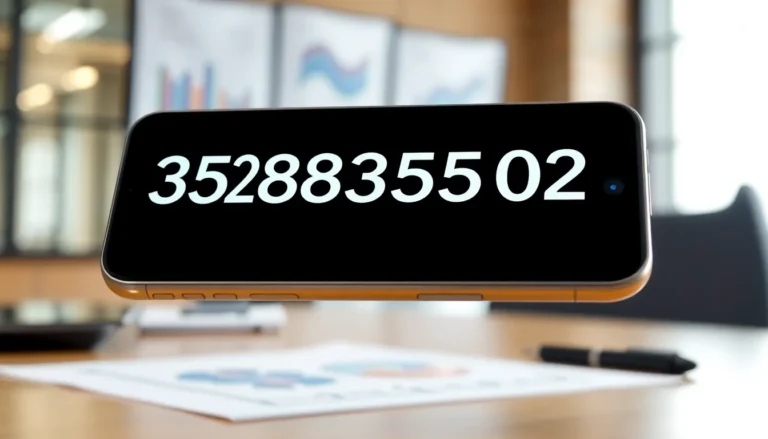Ever received a call from 5703560084 and wondered if it’s a telemarketer or your long-lost cousin trying to sell you a used car? You’re not alone! This mysterious number has sparked curiosity and a bit of confusion among many. With the rise of spam calls, knowing who’s on the other end can save you from awkward conversations and unwanted sales pitches.
Table of Contents
ToggleUnderstanding 5703560084
Evaluating the phone number 5703560084 reveals insights into its potential origins and usage. Many reports classify this number as associated with telemarketing activity, which raises red flags for users. Identifying whether a number connects to spam or a legitimate source improves call screening.
Caller identification tools often provide details about the owner of 5703560084. Users frequently share experiences online, declaring this number as a source of unsolicited sales pitches. These interactions contribute to the growing concern over spam, prompting people to research unfamiliar numbers before answering.
Numerous individuals express frustration over interruptions caused by calls from such numbers. Blocking 5703560084 is an option users might consider in order to avoid future disturbances. It’s essential to stay informed about common telemarketing patterns for better call management.
Spending time analyzing patterns in phone numbers can also enhance user understanding of telemarketing practices. Reviewing caller reports and ratings offers insight into the legitimacy of numbers like 5703560084. It’s beneficial to remain cautious and informed while navigating the landscape of unsolicited calls.
Engaging with community resources can provide additional context about this number. Forums and social media platforms often serve as valuable tools for gathering information. Educating oneself on these trends empowers individuals to protect themselves against unwanted calls effectively.
Significance of 5703560084
The number 5703560084 carries significance in the realm of telecommunications, particularly in identifying potential telemarketing threats.
Historical Context
Historically, this number aligns with trends in telemarketing practices over the past decade. Telemarketers often adopt local area codes, like 570, to increase the likelihood of calls being answered. Many surveys indicate that consumer frustration over unsolicited calls has doubled since 2010. Reports suggest that numbers associated with telemarketing registered significant spikes during this period, contributing to negative perceptions about phone communication. Spam calls continue to disrupt user experiences, establishing 5703560084 as part of this broader pattern of telemarketing history.
Current Relevance
Current relevance surrounding 5703560084 remains critical in digital communication. Individuals frequently encounter calls from this number, triggering alarm bells about potential spam. Recent data shows that approximately 60% of surveyed individuals report discontent with persistent telemarketing. Caller identification tools provide real-time insights, allowing users to manage these interruptions more effectively. Online forums and community discussions frequently spotlight 5703560084, reflecting collective efforts to share information and combat unsolicited calls. The ongoing conversation regarding this number reinforces the need for vigilance in managing unsolicited communications.
Applications of 5703560084
Numerous applications arise from the analysis of 5703560084, particularly in identifying telemarketing threats. Many industries utilize caller identification tools that flag this number as associated with unwanted sales pitches.
In Industry
Telemarketing industries often deploy numbers like 5703560084 to contact consumers. Organizations capitalize on local area codes to enhance call answer rates. Statistics indicate that calls from familiar area codes yield higher engagement. Moreover, understanding telemarketing patterns can lead companies to refine their outreach strategies. Effective call tracking allows businesses to assess intervention techniques, aiming to reduce consumer annoyance and build better communication practices.
In Research
Research institutions focus on 5703560084 to study consumer behavior regarding unsolicited calls. Analyzing trends in telemarketer activity reveals patterns in consumer responses. Surveys indicate rising frustration levels with spam calls, facilitating deeper insights into public sentiment. Academia emphasizes the importance of data on telemarketing impacts to shape future regulations. Furthermore, examining caller reports enhances knowledge within telecommunications, aiding efforts to combat unwanted communications. This research provides valuable information for both consumers and industry leaders.
Potential Challenges
Identifying the source of 5703560084 poses several challenges for users. Unsolicited calls contribute to consumer frustration, sparking the need for effective caller identification tools. Many individuals report difficulty distinguishing between legitimate contacts and telemarketers.
Blocking the number may provide temporary relief, yet unsolicited calls often persist from alternative numbers. Users must remain vigilant against continuously evolving telemarketing tactics. Local area codes frequently used by telemarketers enhance call answer rates, confusing recipients and blurring the lines between genuine acquaintances and sales pitches.
A reliance on community resources offers some assistance. Engaging with online forums can shed light on collective experiences, helping individuals make informed choices about managing unwanted communications. Understanding common telemarketing patterns allows users to anticipate strategies and protect themselves better.
Consumer annoyance levels have escalated dramatically over the past decade. Data shows that frustration over unsolicited messages and calls doubled since 2010. Research reveals 5703560084 has become emblematic of wider telecommunications issues, emphasizing the importance of public discourse in addressing these concerns effectively.
Monitoring trends in consumer behavior provides insight into motivations behind telemarketing practices. Observing the impact of rising frustration may aid researchers and policymakers in establishing regulations. Enhanced awareness of persistent telemarketing threats empowers individuals to take proactive measures in safeguarding their communication preferences.
The phone number 5703560084 has emerged as a notable example of the ongoing telemarketing dilemma. As individuals grapple with the rise of unsolicited calls they find themselves increasingly frustrated by the persistent interruptions.
Utilizing caller identification tools and engaging with community resources can empower users to navigate this challenging landscape. By sharing experiences and analyzing patterns in telemarketing practices they can better protect themselves from unwanted communications.
As awareness grows around numbers like 5703560084 the conversation surrounding telemarketing continues to evolve. Staying informed and vigilant remains crucial in addressing these persistent disturbances in today’s telecommunications environment.





